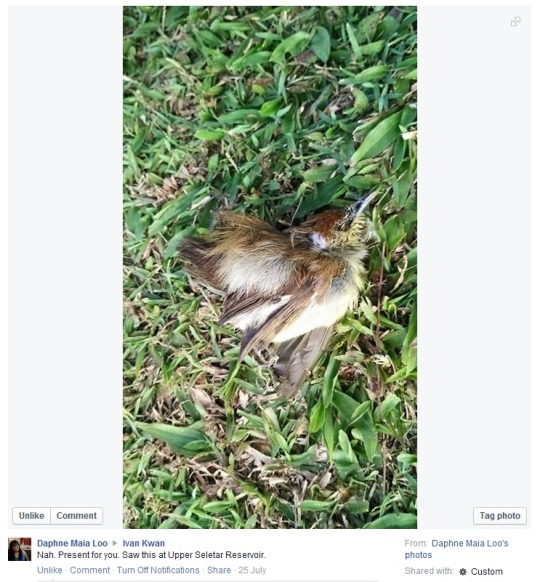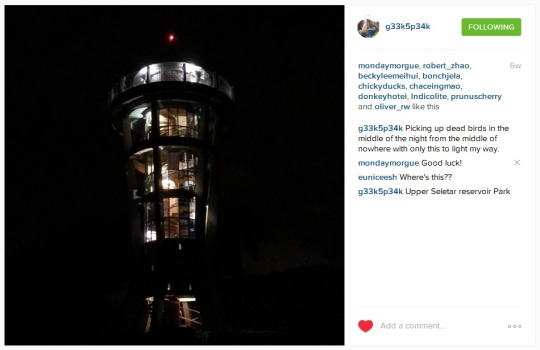Never shot a Blue-winged Pitta (Pitta moluccensis) in my few years of birding and now I see this next to my bar. 😦 It is very sad that during migration season, many birds die from exhaustion, crash etc.
Source: Bernard Seah Facebook
Never shot a Blue-winged Pitta (Pitta moluccensis) in my few years of birding and now I see this next to my bar. 😦 It is very sad that during migration season, many birds die from exhaustion, crash etc.
Source: Bernard Seah Facebook
I found these pitiful dead birds near Blk 601 Ang Mo Kio Ave 5.
Source: Singapore Birders Facebook

We just found a dead migratory bird, the Siberian Blue Robin (Luscinia cyane).
Thank you David Tan from Department of Biological Sciences, NUS for the identification. The specimen will be deposited at the Lee Kong Chian Natural History Museum.

Today’s dead migratory bird is an Eastern Crowned Warbler (Phylloscopus coronatus), a small songbird species that breeds across Eurasia and is a common migrant to Singapore, where it is often found in forested areas. This bird, unfortunately, was found in the middle of Tampines estate, likely lost after a long flight.
Source: David Tan Instagram

Eastern Crowned Warbler (Phylloscopus coronatus)
Migration isn’t easy and not all birds make it. Urban obstacles cause a lot of bird deaths too
Source: Sumita Thiagarajan Instagram

Barn Swallows (Hirundo rustica) feature prominently in children’s literature, but never before have I handled one with my own hands.
Unfortunately, in this instance this Barn Swallow had the misfortune of flying into a glass panel at the NTU Art, Design and Media block, and will now rest in the natural history museum’s collection, where it will contribute to our ongoing research into the bird world.
Source: David Tan Instagram

It seems like we are experiencimg an incredible wave of migrating Yellow-rumped Flycatchers (Ficedula zanthopygia) over these past few days, and many of the young males, such as this individual here, unfortunately crash into glass and meet their end. This poor thing here brings the tally up to 4 casualties recorded over the past 3 days.
Source: David Tan Instagram

The second first winter male Yellow-rumped Flycatcher (Ficedula zanthopygia) in 2 days, also a windowstrike case. Really shows how lethal glass can be for young birds.
Source: David Tan Instagram

With the onset of October comes the first casualty of the migratory season: a young Yellow-rumped Flycatcher (Ficedula zanthopygia) that flew into a third floor window earlier this afternoon at Joo Chiat.
With the migratory season slowly approaching its peak, I would like to appeal to everyone to look out for downed birds over the next few months, especially around the perimeter of your workplace, and call or text me immediately at 91768971 should you come across a dead bird or a bird in distress. Your efforts will greatly help our research into the lives of birds. Thank you.
Source: David Tan Instagram
Pin-striped Tit-babbler (Mixornis gularis)
Upper Seletar Reservoir, 25th July 2015
Daphne Maia Loo, knowing about my morbid fascination with dead animals, posted a photo on my personal Facebook feed, alerting me to a dead bird she had found.

Recognising it as a Pin-striped Tit-babbler, I alerted another friend of mine, David Tan, who not only retrieves bird carcasses for research purposes, but also happens to study this species. He was able to rush down to the location that same evening, and was succesful in locating and collecting the carcass.



It’s interesting whenever social networks intersect due to encounters with wildlife (or in this case, carcasses); ordinary members of the public do have a vital role to play in documenting such encounters and alerting naturalists and researchers. Such an example was seen with the Sperm Whale (Physeter macrocephalus) carcass found off Jurong Island.
In this instance, this Pin-striped Tit-babbler carcass might provide clues as to the cause of death, while gut contents, genetic material, and other samples can give us a better picture of this animal’s life, such as its diet, or whether habitat fragmentation is leading to inbreeding in bird species confined within our forest patches. There’s still so little that we know about Southeast Asian wildlife, and carcasses provide a wealth of data that could be used in future to better protect these species and their habitats.
Find out how you can contribute to Monday Morgue as well.